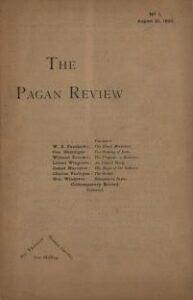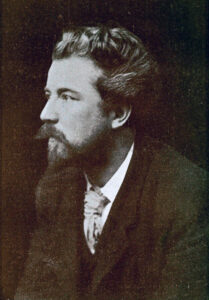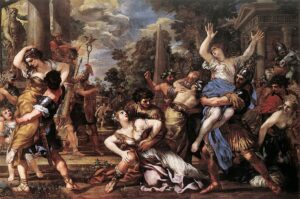Pseudonyms, Female Sexuality and Mediterranean Culture: Feminine Literature and the Masculine Gift
© Copyright 2024 Laura Provenzano, Toronto Metropolitan University
An Introduction to James Marazion’s “The Rape of the Sabines”: A Short story

This short story was published in the first and only edition of The Pagan Review in 1892, James Marazion’s The Rape of the Sabines is an adaption of an incident in the history of Rome. The Sabines refused to allow their women to marry the Romans: this led men of Rome to commit mass abduction in regard to the Sabine women during the festival of Neptune Equester. In Marazion’s short story, it revolves around two Roman men, Andrea Falcone and Marco Vaccaro, and it is quickly revealed that they were in love with two Sabine women, daughters of a man of high nobility in the hill-town of the Sabines, “the gossips of the hill-villages were each and all aware of the love Andrea and Marco bore for Vittoria and Anita,” (Marazion 32)._ The girls’ father swore that whether his daughters were willing or unwilling, they shall only marry pure Sabine blood. It is implied that the girls were closely watched, but had love affairs with the two men; this was possible due to their ally, younger brother Guido. Guido tells Andrea and Marco that the girls are being married off by revealing, “The last night of their virginity,” (Marazion 33). There is long conversation pertaining to virginities and true women in regard to Catholic values. The girls’ approaching loss of virginity creates a sense of urgency within the men that leads them to devise a plan to murder the suitors, Gregorio and Simone. Later on the girls and the suitors entered a bedroom with two white beds, made to take their virginities. Before this deed can be done, Andrea and Marco murder the two men and prop them up on the beds, allowing them to take Anita and Vittoria with them.
In this short story Marazion upholds the Catholic value of chastity, specifically in relation to female autonomy. Further highlighting gendered power dynamics of the 19th century. Although this story deliberately refers to female sexuality and autonomy, it is devoid of female thought and perspective; the apparentness of the silence of women further highlights women’s oppression due to the patriarchal society within the 19th. To continue, the text revolves around women, but the reader never hears from a woman, instead the author chose to emphasise masculinity and control within Mediterranean culture. Further research reveals that James Marazion is a pseudonym for William Sharp, who has written under female pseudonyms such as Fiona Macleod. Since Sharp chooses what gender to write under, this revelation sparks a question: why did he deliberately choose to write this story from a male perspective (male pseudonym) although the plot surrounds female sexuality?
The Rape of The Sabines is being approached through a feminist lens and strives to emphasise how the choice of male pseudonyms reflects in a female centred story as well; the text depicts little to no female autonomy and simply uses women as a ploy or object to further the male protagonist success within the text. This choice abides to historical gender norms; not only does the author choose to silence the female characters, but also disregards the idea of feminine literature.
About The Author

The author of The Rape of the Sabines is James Marazion, one of the many pseudonyms that William Sharp has wrote under. As stated earlier, he did not only write under male pseudonyms, but female as well, such as Fiona Macleod. The author’s ability to use both genders in his writing is quite significant in the 19th century as women were commonly seen as lesser than; a female pseudonym may suggest that he thought men and women were equals within the literary world. The diversity in The Pagan Review is prevalent, despite only having a single author (although he made it seem like it was several), “the issue includes two short stories, two poems, two short dramas, an essay on the genre of the prose-poem, a review-essay entitled “Contemporary Record” addressing books published in England and France, a closing “Editorial,” and pages of advertising” (Denisoff and Kooistra 2). Sharp quickly decided to cease further publication by the time the Saturday Preview printed a commentary on the first issue on The Pagan Review in September of 1892, hence leaving it as a single published volume.
Regarding the male pseudonym Sharp used to author this story with, it is likely that this was a deliberate action. For example, in his works with Celtic subject matter he uses pseudonyms that suggest the author is a descendant of such background, “This contradicts both the nonEnglish pseudonyms he chose to use and the international subjects of the works themselves..foreshadow the Celtic focus of his later publications as Fiona Macleod,” (Denisoff and Kooistra 2).Thus it is evident that Sharp selects his pseudonyms to capture a specific perspective. In this short story, Sharp adopts a male pseudonym to suggest male attitudes towards chastity 19th century.
Mediterranean Culture Depicted in The Rape of the Sabines

Analysing Marazion’s The Rape of The Sabines and its relationship to the male pseudonym, there is specific emphasis being placed on the masculinity within this story. The use of male pseudonyms and focus on female sexuality is relative to Mediterranean/Italian culture in the 19th century. Halvor Monxes’ text, Honor and Shame, studies 19th century Mediterranean culture which regards how aspects of honour and shame were categorised and correlated between men and women. This is specific to gender roles and sexuality. According to Moxnes’ framework on this subject, the dominance of man and the submissiveness of women is emphasised within Moxnes text and specifically the power or honour of a man is maintained by ensuring females close to him remain chaste, “To maintain his honor, a man must be able to defend the chastity of women under his dominance. The loss of their chastity implies shame for the family as a whole,” (Moxnes 168). This quotation strongly relates to the male-protagonists mission or goal within the story; they were essentially trying to “save” their women’s virginity because it would be shameful for them otherwise, making them “potential sources of shame,” (Moxnes 168). Shame is categorised as modesty and morality, there is an implication that women need to feel shame in order to remain chaste, “these virtues that make a woman preserve her chastity as well as her obedience to the man in charge of her,” (Moxnes 23). In this culture, it is important to uphold divisions between male and females, a man must have control over their woman and that includes their sexuality. Much like the story, women do not have autonomy or control over their sexuality,
“Is this thing to be done to-night? Ay, so:I believe you. No, no: I want to hear no more. What does anything else matter. We must be there, too, Marco—if we have to go to our death at the same time,” (Marazion 35).
In this quotation one can understand how important it was for these men to have the women they were in love with to remain virgins–even going so far as to accept their possible death in the process. Marco and Andrea actually murder the two men before they can take Vittoria and Annita’s virginities. This puts emphasis on the importance of women’s virginity in the 19th century as well as referring to Moxnes’ text; men must protect their women’s virginity. The idea of honour and shame is relative to the story as Andrea and Marco are desperate for themselves and their women to remain honourable, this is prevalent to their Mediterranean culture to maintain honour. Therefore, this aids in answering the question of why men were so involved in a woman’s virginity, and more specifically the absence of female autonomy.
Hardships in Female Literature and the Dominance of Masculine Creativity
Not only was there a lack of female autonomy within The Rape of the Sabines, there is a notable absence of female characters opinion on sexuality or perspective in general, even though the story almost completely revolves around their sexuality and relationships. Referring back to Sharp’s choice of writing under a male pseudonym, it has a crucial effect on the story as it abides by 19th century gender norms while also disregarding feminine literature. This was an interesting choice as his ability to use both genders in pseudonyms would suggest that Sharp believes them both to be equals within the literary world, but it seems like there was a deliberate intent to make this story told through a masculine lens. Sandra Gilbert and Susan Gubar’s novel, The Madwoman in the Attic: The Woman Writer and the Nineteenth-Century Literary Imagination, discusses the lack of credibility, undermining and silencing of female voices in terms of literature in the 19th century. During these historical times, there were extreme hardships that followed emerging female authors and patriarchal notions were still prevalent in the literary world, “Is a pen a metaphorical penis? Gerard Manley Hopkins seems to have thought so… ‘The artist’s “most essential quality,” he declared, is “masterly execution, which is a kind of male gift’,” (Gilbert and Gubar 3). Here they are quoting a man’s opinion, one that is commonly held within the 19th century: the male quality is needed for the creative gift.
This concept implies that women cannot be creative, and undermines female writers and disregards their work. The authors say, “the poet’s pen is in some sense (even more than figuratively) a penis,” (Gilbert and Gubar 4). This is an interesting metaphor as this implies male sexuality is the essence of literary power. This is relative to both the pseudonym Sharp used and the in the story itself; a male pseudonym may be used because it is written with male sexuality in mind (the pen is the penis). The story is driven by male power rather than female autonomy. Essentially the story was written by a man to emphasise masculinity and power over female bodies, it is very male oriented as there is a deliberate focus on female virginity which was considered of high importance to men in the 19th century. The values highlighted by the male characters within the story and the absence of female voices concludes that the story was written with a [metaphorical] penis.
Conclusion
In conclusion, the analysation of the high prevalence of masculinity within The Rape of the Sabines is a reflection of gender norms in patriarchal societies as well the literary world, specifically in regards to feminine literature. By noting Sharps deliberateness to use a male pseudonym refers to the hypermasculine perspectives within 19th century Mediterranean culture and concepts of honour and shame–as discussed in Moxnes’ Honor and Shame–regards female virginity and the importance of chastity. The choice of pseudonym is also relative to Gilbert and Gubar’s novel that discusses the common notion that creativity is a masculine trait. The metaphor referring to the pen as a penis refers back to the concept of masculine text written with male sexuality in mind, even if it refers to female autonomy and sexuality. These choices reinforce and highlight the norms within the 19th century and regards to gendered power dynamics; the silence of women (characters and authors) emphasises the dominance of a man.
Works Cited
Denisoff, Dennis. William Sharp [pseud. Fiona Macleod, W.H. Brooks] (1855-1905), Y90s Biographies, 2010. Yellow Nineties 2.0, edited by Lorraine Janzen Kooistra, Ryerson University Centre for Digital Humanities, 2019, https://1890s.ca/sharp_bio/.
Gilbert, Sandra M., and Susan Gubar. The Madwoman in the Attic: The Woman Writer and the Nineteenth-Century Literary Imagination. Yale University Press, 2020. JSTOR, https://doi.org/10.2307/j.ctvxkn74x.
Marazion, James, The Rape of the Sabines” The Pagan Review, vol. 1, 1892, https://1890s.ca/tpr-all/
Moxnes, Halvor. Honor and Shame. Biblical Theology Bulletin, 1993 https://doi-org.ezproxy.lib.torontomu.ca/10.1177/014610799302300405
∗∗∗
Images depicted within this exhibit are in the public domain.
